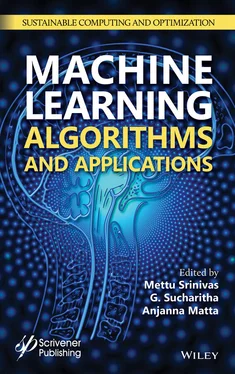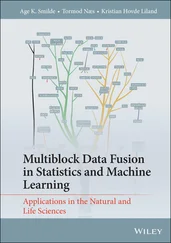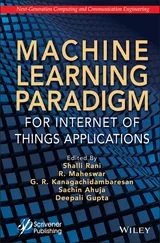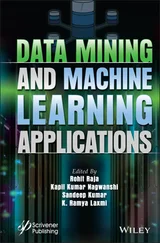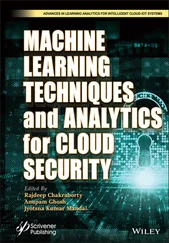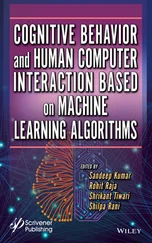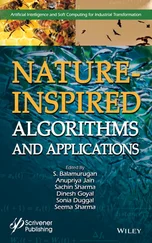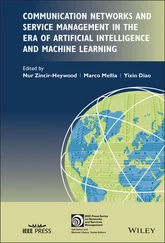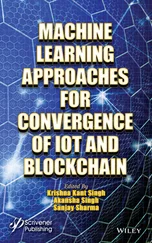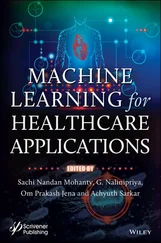Machine Learning Algorithms and Applications
Здесь есть возможность читать онлайн «Machine Learning Algorithms and Applications» — ознакомительный отрывок электронной книги совершенно бесплатно, а после прочтения отрывка купить полную версию. В некоторых случаях можно слушать аудио, скачать через торрент в формате fb2 и присутствует краткое содержание. Жанр: unrecognised, на английском языке. Описание произведения, (предисловие) а так же отзывы посетителей доступны на портале библиотеки ЛибКат.
- Название:Machine Learning Algorithms and Applications
- Автор:
- Жанр:
- Год:неизвестен
- ISBN:нет данных
- Рейтинг книги:4 / 5. Голосов: 1
-
Избранное:Добавить в избранное
- Отзывы:
-
Ваша оценка:
- 80
- 1
- 2
- 3
- 4
- 5
Machine Learning Algorithms and Applications: краткое содержание, описание и аннотация
Предлагаем к чтению аннотацию, описание, краткое содержание или предисловие (зависит от того, что написал сам автор книги «Machine Learning Algorithms and Applications»). Если вы не нашли необходимую информацию о книге — напишите в комментариях, мы постараемся отыскать её.
Machine Learning Algorithms and Applications — читать онлайн ознакомительный отрывок
Ниже представлен текст книги, разбитый по страницам. Система сохранения места последней прочитанной страницы, позволяет с удобством читать онлайн бесплатно книгу «Machine Learning Algorithms and Applications», без необходимости каждый раз заново искать на чём Вы остановились. Поставьте закладку, и сможете в любой момент перейти на страницу, на которой закончили чтение.
Интервал:
Закладка:
Table of Contents
1 Cover
2 Title Page
3 Copyright This edition first published 2021 by John Wiley & Sons, Inc., 111 River Street, Hoboken, NJ 07030, USA and Scrivener Publishing LLC, 100 Cummings Center, Suite 541J, Beverly, MA 01915, USA © 2021 Scrivener Publishing LLC For more information about Scrivener publications please visit www.scrivenerpublishing.com . All rights reserved. No part of this publication may be reproduced, stored in a retrieval system, or transmitted, in any form or by any means, electronic, mechanical, photocopying, recording, or otherwise, except as permitted by law. Advice on how to obtain permission to reuse material from this title is available at http://www.wiley.com/go/permissions . Wiley Global Headquarters 111 River Street, Hoboken, NJ 07030, USA For details of our global editorial offices, customer services, and more information about Wiley products visit us at www.wiley.com . Limit of Liability/Disclaimer of Warranty While the publisher and authors have used their best efforts in preparing this work, they make no representations or warranties with respect to the accuracy or completeness of the contents of this work and specifically disclaim all warranties, including without limitation any implied warranties of merchantability or fitness for a particular purpose. No warranty may be created or extended by sales representatives, written sales materials, or promotional statements for this work. The fact that an organization, website, or product is referred to in this work as a citation and/or potential source of further information does not mean that the publisher and authors endorse the information or services the organization, website, or product may provide or recommendations it may make. This work is sold with the understanding that the publisher is not engaged in rendering professional services. The advice and strategies contained herein may not be suitable for your situation. You should consult with a specialist where appropriate. Neither the publisher nor authors shall be liable for any loss of profit or any other commercial damages, including but not limited to special, incidental, consequential, or other damages. Further, readers should be aware that websites listed in this work may have changed or disappeared between when this work was written and when it is read. Library of Congress Cataloging-in-Publication Data ISBN 978-1-119-76885-2 Cover image: Pixabay.Com Cover design by Russell Richardson
4 Acknowledgments
5 Preface
6 Part 1: Machine Learning for Industrial Applications Part 1 MACHINE LEARNING FOR INDUSTRIAL APPLICATIONS
1 A Learning-Based Visualization Application for Air Quality Evaluation During COVID-19 Pandemic in Open Data Centric Services 1 A Learning-Based Visualization Application for Air Quality Evaluation During COVID-19 Pandemic in Open Data Centric Services Priyank Jain* and Gagandeep Kaur† Dept. of CSE & IT, Jaypee Institute of Information Technology, Noida, Uttar Pradesh, India Abstract Air pollution has become a major concern in many developing countries. There are various factors that affect the quality of air. Some of them are Nitrogen Dioxide (NO 2 ), Ozone (O 3 ), Particulate Matter 10 (PM 10 ), Particulate Matter 2.5 (PM 2.5 ), Sulfur Dioxide (SO 2 ), and Carbon Monoxide (CO). The Government of India under the Open Data Initiative provides data related to air pollution. Interpretation of this data requires analysis, visualization, and prediction. This study proposes machine learning and visualization techniques for air pollution. Both supervised and unsupervised learning techniques have been used for prediction and analysis of air quality at major places in India. The data used in this research contains the presence of six major air pollutants in a given area. The work has been extended to study the impact of lockdown on air pollution in Indian cities as well. Keywords: Open Data, JSON API, OpenAQ, clustering, SVM, LSTM, prediction, Heat Map visualizations
1.1 Introduction 1.1 Introduction 1.1.1 Open Government Data Initiative These days, Open Government Data (OGD) is gaining momentum in providing sharing of knowledge by making public data and information of governmental bodies freely available to private citizens in system processable formats so as to reuse it for mutual benefits. OGD is a global movement and has its roots in the initiative started in 2009 by the US President as a Memorandum on Transparency and Open Government providing transparency in government projects and collaborations through sharing of data by public administration and industry to private citizens. Indian Government also has joined this initiative and provides free access to the data for development of applications, etc., so as to be able to reuse the information for mutual growth of industry and government. Open Data is the raw data made available by governments, industry, as well as NGOs, scientific institutions, and educational organizations and as such is not an individual’s property. The growth in the field of Open Data surely asks for new tools and techniques that can support it. Digital transformation needs companies to look out for new tools and techniques so as to be able to support the increasing need for faster delivery of services at large numbers of delivery points. Technologies like SaaS, mobile, and Internet of Things are gaining grounds in providing increase in endpoints and thus enabling the success of Open Data Initiative.
1.2 Literature Survey 1.3 Implementation Details 1.4 Results and Discussions 1.5 Conclusion References 2 Automatic Counting and Classification of Silkworm Eggs Using Deep Learning 2.1 Introduction 2.2 Conventional Silkworm Egg Detection Approaches 2.3 Proposed Method 2.4 Dataset Generation 2.5 Results 2.6 Conclusion Acknowledgment References 3 A Wind Speed Prediction System Using Deep Neural Networks 3.1 Introduction 3.2 Methodology 3.3 Results and Discussions 3.4 Conclusion References 4 Res-SE-Net: Boosting Performance of ResNets by Enhancing Bridge Connections 4.1 Introduction 4.2 Related Work 4.3 Preliminaries 4.4 Proposed Model 4.5 Experiments 4.6 Results 4.7 Conclusion References 5 Sakshi Aggarwal, Navjot Singh and K.K. Mishra 5.1 Genesis 5.2 The Big Picture: Artificial Neural Network 5.3 Delineating the Cornerstones 5.4 Deep Learning Architectures 5.5 Why is CNN Preferred for Computer Vision Applications? 5.6 Unravel Deep Learning in Medical Diagnostic Systems 5.7 Challenges and Future Expectations 5.8 Conclusion References 6 Two-Stage Credit Scoring Model Based on Evolutionary Feature Selection and Ensemble Neural Networks 6.1 Introduction 6.2 Literature Survey 6.3 Proposed Model for Credit Scoring 6.4 Results and Discussion 6.5 Conclusion References 7 Enhanced Block-Based Feature Agglomeration Clustering for Video Summarization 7.1 Introduction 7.2 Related Works 7.3 Feature Agglomeration Clustering 7.4 Proposed Methodology 7.5 Results and Analysis 7.6 Conclusion References
7 Part 2: Machine Learning for Healthcare Systems 8 Cardiac Arrhythmia Detection and Classification From ECG Signals Using XGBoost Classifier 8.1 Introduction 8.2 Materials and Methods 8.3 Results and Discussion 8.4 Conclusion References 9 GSA-Based Approach for Gene Selection from Microarray Gene Expression Data 9.1 Introduction 9.2 Related Works 9.3 An Overview of Gravitational Search Algorithm 9.4 Proposed Model 9.5 Simulation Results 9.6 Conclusion References
8 Part 3: Machine Learning for Security Systems 10 On Fusion of NIR and VW Information for Cross-Spectral Iris Matching 10.1 Introduction 10.2 Preliminary Details 10.3 Experiments and Results 10.4 Conclusions References 11 Fake Social Media Profile Detection 11.1 Introduction 11.2 Related Work 11.3 Methodology 11.4 Experimental Results 11.5 Conclusion and Future Work Acknowledgment References 12 Extraction of the Features of Fingerprints Using Conventional Methods and Convolutional Neural Networks 12.1 Introduction 12.2 Related Work 12.3 Methods and Materials 12.4 Results 12.5 Conclusion Acknowledgements References 13 Facial Expression Recognition Using Fusion of Deep Learning and Multiple Features 13.1 Introduction 13.2 Related Work 13.3 Proposed Method 13.4 Experimental Results 13.5 Conclusion Acknowledgement References
Читать дальшеИнтервал:
Закладка:
Похожие книги на «Machine Learning Algorithms and Applications»
Представляем Вашему вниманию похожие книги на «Machine Learning Algorithms and Applications» списком для выбора. Мы отобрали схожую по названию и смыслу литературу в надежде предоставить читателям больше вариантов отыскать новые, интересные, ещё непрочитанные произведения.
Обсуждение, отзывы о книге «Machine Learning Algorithms and Applications» и просто собственные мнения читателей. Оставьте ваши комментарии, напишите, что Вы думаете о произведении, его смысле или главных героях. Укажите что конкретно понравилось, а что нет, и почему Вы так считаете.
